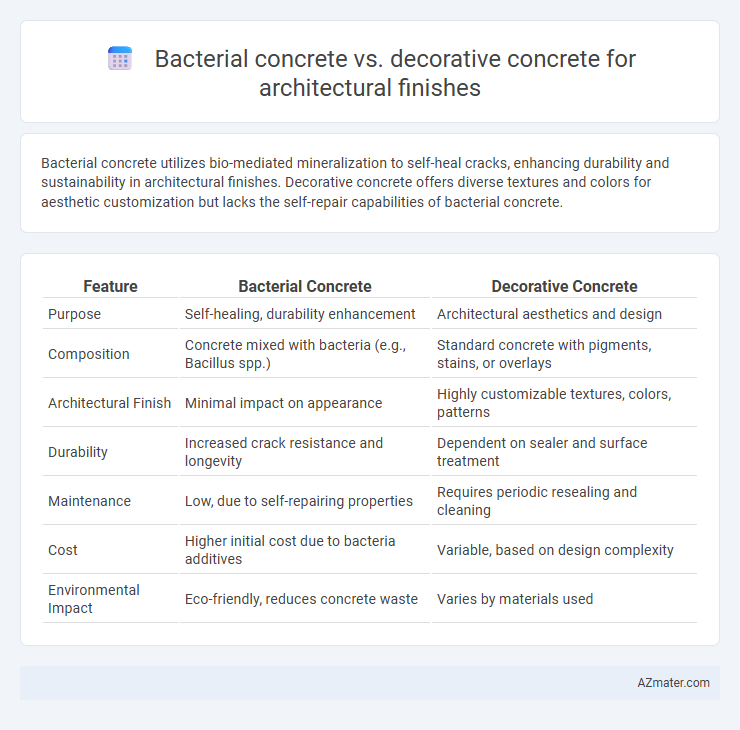Bacterial concrete utilizes bio-mediated mineralization to self-heal cracks, enhancing durability and sustainability in architectural finishes. Decorative concrete offers diverse textures and colors for aesthetic customization but lacks the self-repair capabilities of bacterial concrete.
Table of Comparison
| Feature | Bacterial Concrete | Decorative Concrete |
|---|---|---|
| Purpose | Self-healing, durability enhancement | Architectural aesthetics and design |
| Composition | Concrete mixed with bacteria (e.g., Bacillus spp.) | Standard concrete with pigments, stains, or overlays |
| Architectural Finish | Minimal impact on appearance | Highly customizable textures, colors, patterns |
| Durability | Increased crack resistance and longevity | Dependent on sealer and surface treatment |
| Maintenance | Low, due to self-repairing properties | Requires periodic resealing and cleaning |
| Cost | Higher initial cost due to bacteria additives | Variable, based on design complexity |
| Environmental Impact | Eco-friendly, reduces concrete waste | Varies by materials used |
Introduction to Architectural Concrete Finishes
Architectural concrete finishes enhance the aesthetic and functional qualities of structures by integrating materials like bacterial concrete and decorative concrete. Bacterial concrete utilizes bio-mediated processes to improve durability and self-healing properties, reducing maintenance costs and increasing lifespan. Decorative concrete offers versatile textures, colors, and patterns, providing customizable visual appeal for architectural surfaces.
What is Bacterial Concrete?
Bacterial concrete is an innovative construction material that incorporates specific bacteria such as Bacillus pasteurii to precipitate calcium carbonate, which heals cracks and enhances durability by self-repairing micro-damages. Unlike decorative concrete, which primarily focuses on aesthetic finishes through pigments, stamps, and textures, bacterial concrete improves structural longevity and reduces maintenance costs by actively preventing crack propagation. This bio-based technology offers sustainable benefits by reducing the need for repairs, thereby extending the lifespan of architectural finishes.
What is Decorative Concrete?
Decorative concrete refers to concrete that has been enhanced with various techniques such as staining, stamping, polishing, or engraving to achieve aesthetic appeal while maintaining structural integrity. It is widely used in architectural finishes to create visually attractive surfaces with customizable patterns, colors, and textures suitable for both interior and exterior applications. Unlike bacterial concrete, which focuses on self-healing properties, decorative concrete emphasizes design and artistic expression in construction and landscaping projects.
Key Differences Between Bacterial and Decorative Concrete
Bacterial concrete incorporates microbial calcite precipitation to self-heal cracks and enhance durability, whereas decorative concrete emphasizes aesthetic enhancements through stamping, staining, and polishing techniques. Bacterial concrete improves structural longevity by reducing maintenance costs, while decorative concrete prioritizes design versatility and visual appeal for architectural finishes. The key difference lies in bacterial concrete's functional self-repair properties versus decorative concrete's focus on varied textures, colors, and patterns for architectural aesthetics.
Strength and Durability: Bacterial vs Decorative Concrete
Bacterial concrete demonstrates superior strength and durability due to its self-healing properties, where bacteria precipitate calcium carbonate to seal microcracks, enhancing longevity and resistance to environmental damage. Decorative concrete primarily focuses on aesthetic appeal, often incorporating surface treatments that may compromise its structural integrity over time under harsh conditions. While decorative concrete excels in visual customization, bacterial concrete offers a more robust solution for architectural finishes requiring enhanced durability and maintenance reduction.
Aesthetic Possibilities in Decorative and Bacterial Concrete
Decorative concrete offers extensive aesthetic possibilities with customizable colors, textures, and patterns, making it ideal for creative architectural finishes that enhance visual appeal. Bacterial concrete, while primarily valued for its self-healing properties, can also contribute to unique surface textures through microbially induced calcite precipitation, offering subtle organic finishes. The choice between the two depends on whether the priority is vibrant, design-driven aesthetics or sustainable, self-repairing surfaces with distinctive natural patterns.
Environmental Impact and Sustainability
Bacterial concrete enhances sustainability by utilizing microbial-induced calcite precipitation to self-heal cracks, reducing the need for repairs and extending structural lifespan, which lowers overall resource consumption and carbon footprint. Decorative concrete often relies on synthetic additives and surface coatings that may involve volatile organic compounds (VOCs) and frequent maintenance, potentially increasing environmental impact. Choosing bacterial concrete supports eco-friendly architectural finishes by promoting durability, reducing waste, and minimizing harmful emissions compared to traditional decorative concrete options.
Cost Comparison: Bacterial Concrete vs Decorative Concrete
Bacterial concrete generally involves higher initial costs due to the incorporation of specialized bacteria and bio-enzymes that enhance self-healing properties, reducing long-term maintenance expenses. Decorative concrete, while often less expensive upfront, requires additional expenses for surface treatments, coloring, and sealing to maintain aesthetic appeal over time. Over the lifespan of a structure, bacterial concrete can offer cost savings by minimizing repairs and extending durability, whereas decorative concrete emphasizes upfront aesthetic customization with variable maintenance costs depending on exposure and usage.
Applications in Modern Architectural Projects
Bacterial concrete enhances durability and self-healing capabilities, making it ideal for infrastructure exposed to harsh environmental conditions and reducing maintenance in modern architectural projects. Decorative concrete provides aesthetic versatility with customizable textures, colors, and patterns, widely used in interior flooring, facades, and landscaping to achieve unique visual effects. Combining bacterial concrete's functional benefits with decorative finishes addresses both structural integrity and design appeal in contemporary architecture.
Future Trends in Concrete Finishes
Bacterial concrete offers innovative self-healing properties that enhance durability and sustainability, making it a promising future trend in architectural finishes. Decorative concrete continues to evolve with advanced pigmentation, stamping techniques, and textured surfaces that provide aesthetic versatility and customization. The integration of eco-friendly materials and smart technologies is set to drive the next generation of concrete finishes, combining functionality with striking visual appeal.

Infographic: Bacterial concrete vs Decorative concrete for Architectural finish
 azmater.com
azmater.com